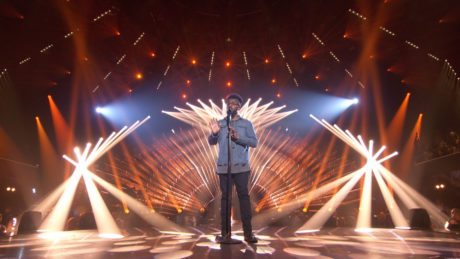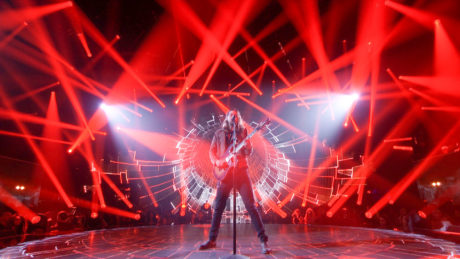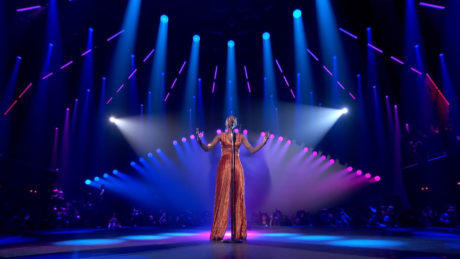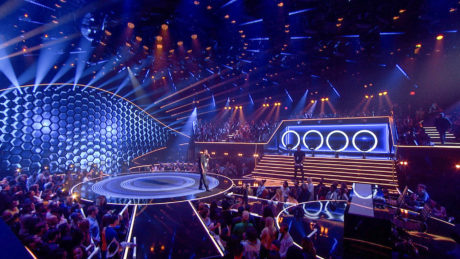
LOS ANGELES – ‘The Four: Battle for Stardom’ – AKA ‘The Four’ – is a new US reality TV show and singing competition produced by ITV Entertainment and Armoza Formats, with the second season just completed following a successful premier on Fox at the start of the year.
More details from Robe (www.robe.cz):
Lighting designer Tom Sutherland of DX7 DESIGN produced a large scale immersive 360-degree lighting environment for this second season. It was a distinctive aesthetic shift from the look and feel of the first season, and this time around, he included Robe MegaPointes and Spiiders on the rig.
The show was recorded in Studio 14 of the CBS Studio Centre in LA and the lighting equipment was supplied by California based Felix Lighting.

The program format does not feature stage auditions. The artists – also known as the challengers – are placed in a ‘holding room’ before coming into the studio to sing in front of a live audience and three judges (currently Sean Combs, DJ Khaled and Megan Trainor) who decide on the best to compete against ‘The Four’. ‘The Four’ vocalists come from assorted genres and must win challenges against the new artists to keep their seat. At the end of the eight-episode series, the last singer standing amongst “The Four” …. wins the competition.
An elaborate set involving substantial LED structures was produced by Florian Wieder of Wieder Design, a master creator of digital scenery, sets and environments, which are exciting and dynamic for TV and talent competitions. The lighting rig was also large, and gave Tom plenty of imaginative scope and latitude to produce radical and different looks for the many different performances each week.
His biggest challenges for the lighting were that while it’s very different from a rock ‘n’ roll or concert scenario, you still have to work with the same lighting rig in the same positions for eight weeks … each week, while making it look vibrant and interesting. Needing to light around 20 new songs for each episode, this is an intense process!

With this in mind Tom tried to integrate as many varied elements into the lighting design as possible, all shaped to create a 360-degree space more like a club in ambience and appearance than a TV studio.
Program director Phil Heyes also embraced this concept, and how all the different departments could benefit from this spaceship style vibe.
As Tom was presenting ideas for changing the look from Season 1, Nicole Barnes, his account handler at Felix Lighting mentioned that they had recently acquired more Robe MegaPointes and Spiiders, and wondered if he wanted to use these on the rig.
Still impressed with the versatility of the original Pointe, he jumped at the chance of using MegaPointes and finding out the buzz about these fixtures first hand.
The 28 x MegaPointes were positioned above what they called ‘The Frown’ a curved truss which provided a proscenium style mask for the central video wall, also curved, and as such was the icon-piece of the lighting design. Everything on the rig fed visually into the center circle of lighting just behind the Frown.

He was “totally blown away” when he saw the MegaPointe action in situ for the first time and thinks the colors are “excellent for TV.” From now on he figures, they will be “my favorite new fixtures!”
Twenty-eight out of a total of 56 x Spiiders were hung immediately below the MegaPointes on the bottom of the Frown, along its curvature, and these were used extensively for all their various effects including the washes, beams and the center flower, “It has all the oomph of an HMI lamp,” declared Tom, who’d been looking at using Spiiders for some time on a TV show, and this seemed a “perfect” opportunity.
The remaining Spiiders were all dotted around the Circle, retaining a central piece of the action. “I love the colors and the punch of these plus all the additional things you can get out of them over and above a standard LED wash light.”
He feels that MegaPointes and Spiiders are “perfect tools” for shows like The Four where you need to get 8 weeks of dramatically different looks for multiple songs each week and where the pressure is on to “WOW fans who are watching the whole series every time”.
He worked with two operators on Season 2, Joe Holdman who looked after the whole lighting rig and Nate Files who dealt with the screens and video content, both using grandMA2 full size consoles. Their four-day weeks started with one day of just the lighting team; for the second they would get the chance to dry-block with the performers, and this was followed by a camera day … then the show day.
The series creative director was Justin Mabardi and the ITV America producers were David Friedman and Becca Walker.
Photos : courtesy Tom Sutherland / ITV America / FOX.


